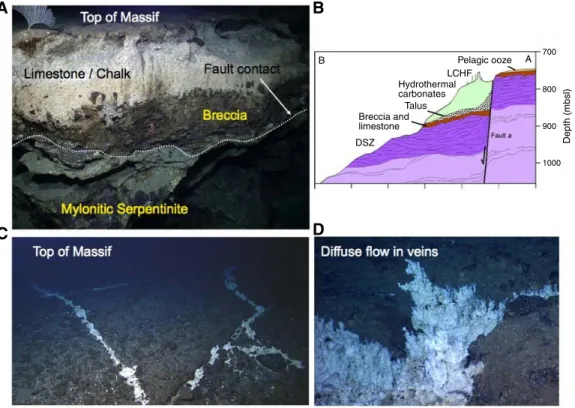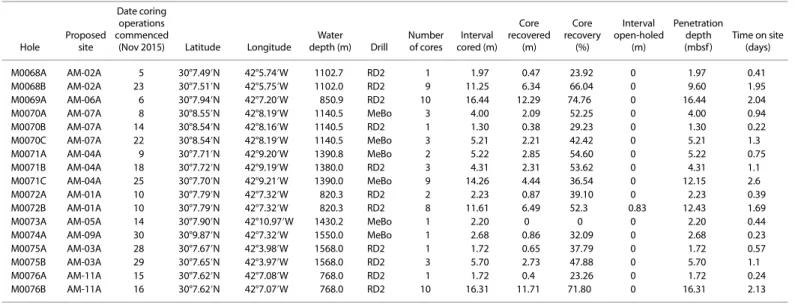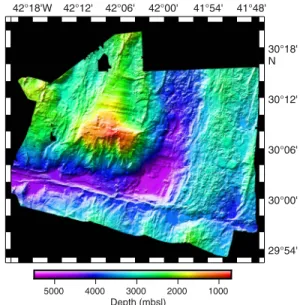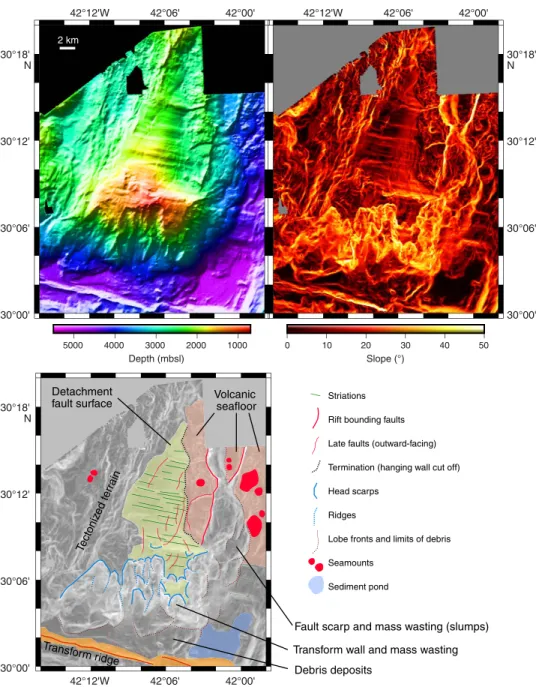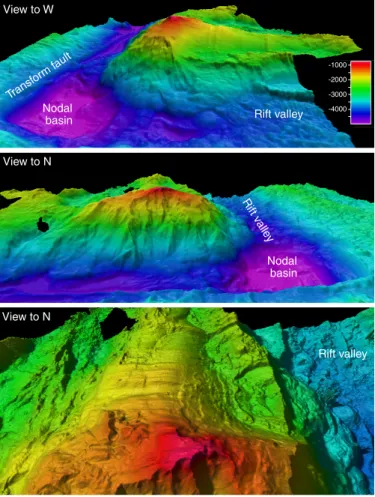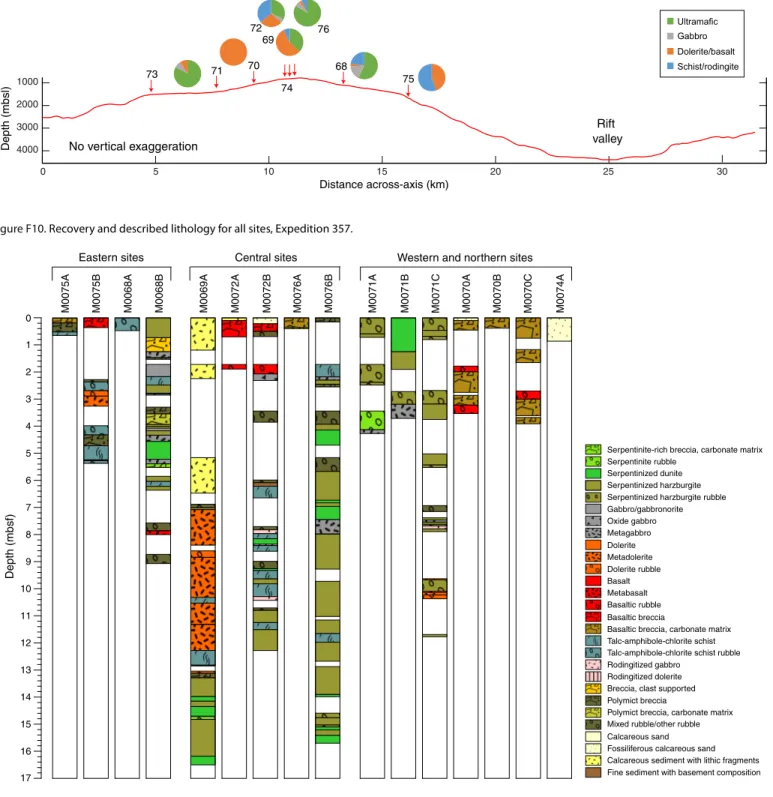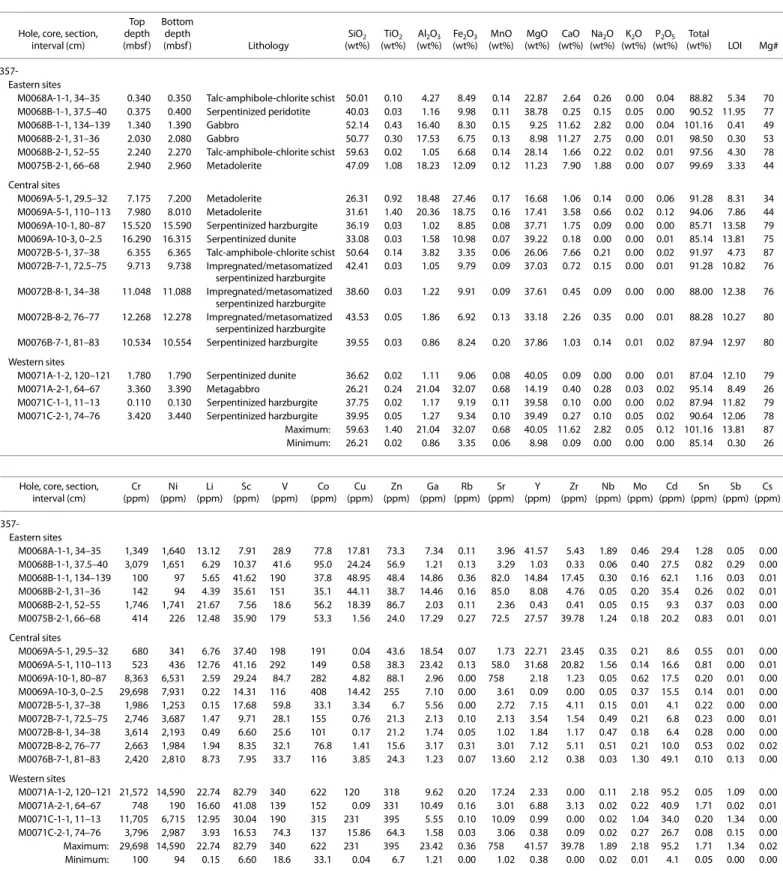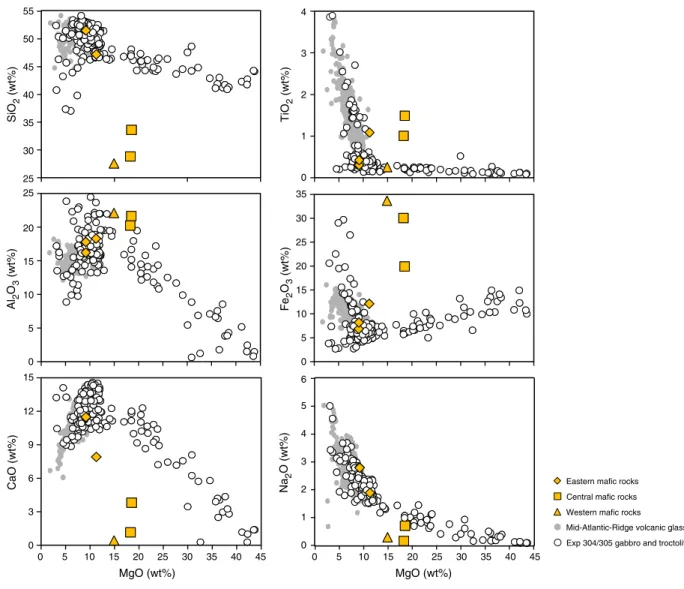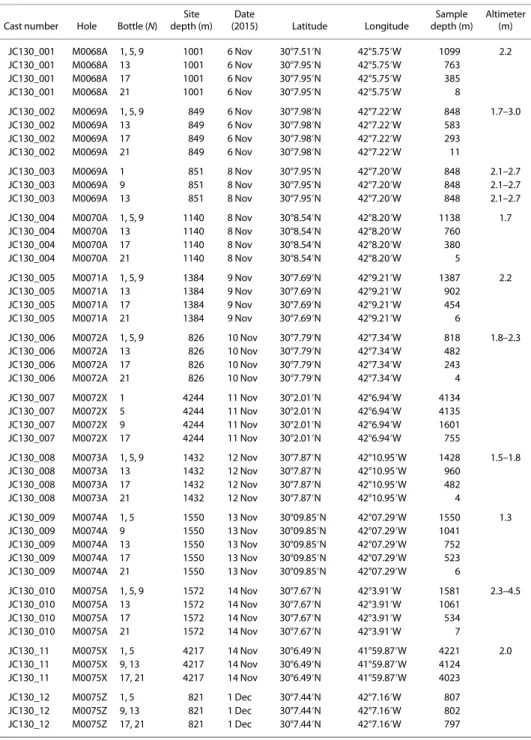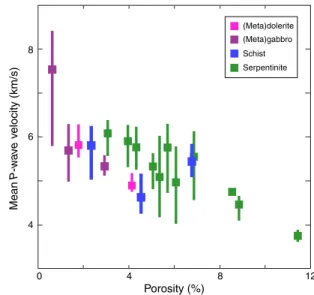Proceedings of the International Ocean Discovery Program Volume 357 publications.iodp.org
doi:10.14379/iodp.proc.357.101.2017
Expedition 357 summary
1G.L. Früh-Green, B.N. Orcutt, S.L. Green, C. Cotterill, S. Morgan, N. Akizawa, G. Bayrakci, J.-H. Behrmann, C. Boschi, W.J. Brazleton, M. Cannat, K.G. Dunkel, J. Escartin, M. Harris, E. Herrero-Bervera, K. Hesse, B.E. John, S.Q. Lang, M.D. Lilley, H.-Q. Liu, L.E. Mayhew, A.M. McCaig, B. Menez, Y. Morono, M. Quéméneur, S. Rouméjon, A. Sandaruwan Ratnayake, M.O. Schrenk, E.M. Schwarzenbach, K.I. Twing, D. Weis, S.A. Whattham, M. Williams, and R. Zhao2
Keywords: International Ocean Discovery Program, IODP, RRS James Cook, Expedition 357, Site M0068, Site M0069, Site M0070, Site M0071, Site M0072, Site M0073, Site M0074, Site M0075, Site M0076, seabed drills, RD2, MeBo, Atlantis Massif, Atlantis Fracture Zone, Mid- Atlantic Ridge, Lost City hydrothermal field, serpentinization, detachment faulting, oceanic core complex, hydrogen, methane, deep biosphere, carbon cycling, carbon sequestration, contamination tracer testing
1Früh-Green, G.L., Orcutt, B.N., Green, S.L., Cotterill, C., Morgan, S., Akizawa, N., Bayrakci, G., Behrmann, J.-H., Boschi, C., Brazleton, W.J., Cannat, M., Dunkel, K.G., Escartin, J., Harris, M., Herrero-Bervera, E., Hesse, K., John, B.E., Lang, S.Q., Lilley, M.D., Liu, H.-Q., Mayhew, L.E., McCaig, A.M., Menez, B., Morono, Y., Quéméneur, M., Rouméjon, S., Sandaruwan Ratnayake, A., Schrenk, M.O., Schwarzenbach, E.M., Twing, K.I., Weis, D., Whattham, S.A., Williams, M., and Zhao, R., 2017. Expedition 357 summary. In Früh-Green, G.L., Orcutt, B.N., Green, S.L., Cot- terill, C., and the Expedition 357 Scientists, Atlantis Massif Serpentinization and Life. Proceedings of the International Ocean Discovery Program, 357: College Station, TX (International Ocean Discovery Program). http://dx.doi.org/10.14379/iodp.proc.357.101.2017
Contents
1 Abstract 2 Introduction 2 Background 5 Drill sites
7 Scientific objectives 9 Operational strategy 12 Summary of achievements 12 Principal expedition results 26 Preliminary scientific assessment 27 Offshore operations
29 Outreach and communication 29 References
Abstract
International Ocean Discovery Program (IODP) Expedition 357 successfully cored an east–west transect across the southern wall of Atlantis Massif on the western flank of the Mid-Atlantic Ridge (MAR) to study the links between serpentinization processes and microbial activity in the shallow subsurface of highly altered ultra- mafic and mafic sequences that have been uplifted to the seafloor along a major detachment fault zone. The primary goals of this ex- pedition were to (1) examine the role of serpentinization in driving hydrothermal systems, sustaining microbial communities, and se- questering carbon; (2) characterize the tectonomagmatic processes that lead to lithospheric heterogeneities and detachment faulting;
and (3) assess how abiotic and biotic processes change with varia- tions in rock type and progressive exposure on the seafloor. To ac- complish these objectives, we developed a coring and sampling strategy centered on the use of seabed drills—the first time that such systems have been used in the scientific ocean drilling pro- grams. This technology was chosen in the hope of achieving high recovery of the carbonate cap sequences and intact contact and de- formation relationships. The expedition plans also included several engineering developments to assess geochemical parameters during drilling; sample bottom water before, during, and after drilling; sup- ply synthetic tracers during drilling for contamination assessment;
acquire in situ electrical resistivity and magnetic susceptibility mea- surements for assessing fractures, fluid flow, and extent of ser- pentinization; and seal boreholes to provide opportunities for future experiments.
Seventeen holes were drilled at nine sites across Atlantis Massif, with two sites on the eastern end of the southern wall (Sites M0068 and M0075), three sites in the central section of the southern wall north of the Lost City hydrothermal field (Sites M0069, M0072, and M0076), two sites on the western end (Sites M0071 and M0073), and two sites north of the southern wall in the direction of the cen- tral dome of the massif and Integrated Ocean Drilling Program Site U1309 (Sites M0070 and M0074). Use of seabed drills enabled col- lection of more than 57 m of core, with borehole penetration rang- ing from 1.30 to 16.44 meters below seafloor and core recoveries as high as 74.76% of total penetration. This high level of recovery of shallow mantle sequences is unprecedented in the history of ocean drilling. The cores recovered along the southern wall of Atlantis Massif have highly heterogeneous lithologies, types of alteration, and degrees of deformation. The ultramafic rocks are dominated by harzburgites with intervals of dunite and minor pyroxenite veins, as well as gabbroic rocks occurring as melt impregnations and veins, all of which provide information about early magmatic processes and the magmatic evolution in the southernmost portion of Atlantis Massif. Dolerite dikes and basaltic rocks represent the latest stage of magmatic activity. Overall, the ultramafic rocks recovered during Expedition 357 reveal a high degree of serpentinization, as well as metasomatic talc-amphibole-chlorite overprinting and local rodin- gitization. Metasomatism postdates an early phase of serpentiniza- tion but predates late-stage intrusion and alteration of dolerite dikes and the extrusion of basalt. The intensity of alteration is generally lower in the gabbroic and doleritic rocks. Chilled margins in doler- ite intruded into talc-amphibole-chlorite schists are observed at the
most eastern Site M0075. Deformation in Expedition 357 cores is variable and dominated by brecciation and formation of localized shear zones; the degree of carbonate veining was lower than antici- pated. All types of variably altered and deformed ultramafic and mafic rocks occur as components in sedimentary breccias and as fault scarp rubble. The sedimentary cap rocks include basaltic brec- cias with a carbonate sand matrix and/or fossiliferous carbonate.
Fresh glass on basaltic components was observed in some of the breccias.
The expedition also successfully applied new technologies, namely (1) extensively using an in situ sensor package and water sampling system on the seabed drills for evaluating real-time dis- solved oxygen and methane, pH, oxidation-reduction potential (ORP), temperature, and conductivity during drilling; (2) deploying a borehole plug system for sealing seabed drill boreholes at four sites to allow access for future sampling; and (3) proving that tracers can be delivered into drilling fluids when using seabed drills. The rock drill sensor packages and water sampling enabled detection of elevated dissolved methane and hydrogen concentrations during and/or after drilling, with “hot spots” of hydrogen observed over Sites M0068–M0072 and methane over Sites M0070–M0072. Ship- board determination of contamination tracer delivery confirmed appropriate sample handling procedures for microbiological and geochemical analyses, which will aid all subsequent microbiological investigations that are part of the science party sampling plans and will verify this new tracer delivery technology for seabed drill rigs.
Shipboard investigation of biomass density in select samples re- vealed relatively low and variable cell densities, and enrichment ex- periments set up shipboard reveal growth. Thus, we anticipate achieving many of the deep biosphere–related objectives of the ex- pedition through continued scientific investigation in the coming years.
Finally, although not an objective of the expedition, we were ser- endipitously able to generate a high-resolution (20 m per pixel) multibeam bathymetry map across the entire Atlantis Massif and the nearby fracture zone, MAR, and eastern conjugate, taking ad- vantage of weather and operational downtime. This will assist sci- ence party members in evaluating and interpreting tectonic and mass-wasting processes at Atlantis Massif.
Introduction
Drilling at Atlantis Massif focuses on two relatively recent dis- coveries in marine geosciences: off-axis serpentinite-hosted fluid circulation as exemplified by the Lost City hydrothermal field (LCHF) and oceanic core complexes (OCCs) as major components of slow-spreading ridges. An estimated 40% or more of the Atlantic Ocean floor was formed by interlinked processes of asymmetric ex- tension, magmatism, and detachment faulting resulting in exposure of mantle and lower crustal rocks in OCCs (Dick et al., 2008; Cannat et al., 2006; Smith et al., 2006, 2008; Ildefonse et al., 2007; Escartín et al., 2003; Tucholke et al., 2008). OCCs incorporate highly reactive olivine-rich rocks that interact with seawater over a range of tem- peratures to produce both high- and low-temperature hydrother- mal systems (Douville et al., 1997, 2002; Charlou et al., 1998, 2002;
Sagalevich et al., 2000; Kelley et al., 2005; McCaig et al., 2007).
Chemical exchange between the mantle and the hydrosphere sup- ports abundant microbial communities in regions of focused fluid discharge in both types of systems (Schrenk et al., 2004; Takai et al., 2004; Nercessian et al., 2005; Brazelton et al., 2006; Campbell et al., 2006; Perner et al., 2007). However, it is unknown whether active
microbial communities are also sustained by fluid–rock interaction in mantle-derived host rocks or in diffusely venting areas that sur- round focused-flow sites. At Atlantis Massif, we can study bio- geochemical and tectonomagmatic processes related to three phases in the evolution of an OCC:
1. Serpentinization processes associated with active fluid discharge at the LCHF and the influence of serpentinization on microbial communities in a range of environments, including carbonate sediments, alteration in both ultramafic and mafic rocks, and zones of subsurface fluid flow of various intensities.
2. Evolution of the massif and the effects of alteration processes on microbial activity as it was progressively denuded to the seafloor and rapidly cooled from around 1 Ma onward. This includes un- derstanding the longevity of and possible precursors to the LCHF, determining the evolution of serpentinization with pro- gressive denudation, and evaluating variations in microbial communities with seafloor age and as the dominant lithology changes from ultramafic to mafic in composition.
3. Early history of the detachment fault, which localized high strain deformation and fluid flow at 300°–400°C (Schroeder and John, 2004; Boschi et al., 2006; Karson et al., 2006; Escartín et al., 2003), possibly as deep as several kilometers below the seafloor.
Background
Active serpentinite-hosted hydrothermal systems and chemical exchange between the mantle,
biosphere, and hydrosphere
Approximately 30,000 km or roughly 50% of the global mid- ocean ridges are spreading at rates <40 mm/y and extend from the Arctic Ocean, along the entire MAR, and into the southwest Indian Ocean. The recognition that ultramafic rocks are tectonically em- placed along major normal faults at these slow-spreading ridge en- vironments has led to new considerations of the geophysical, geochemical, and biological consequences of serpentinization for the global marine system (Figure F1) (Cannat, 1993; Dick et al., 2003, 2008; Smith et al., 2006; Escartín et al., 2003). Serpentiniza- tion is associated with the uptake or release of many major and mi- nor components, such as H2O, Mg, Ca, Si, Cl, Li, B, C, and S, with important consequences for long-term global geochemical fluxes and biogeochemical cycles (Alt and Shanks, 1998, 2003, 2006; Früh- Green et al., 2004; Boschi et al., 2008; Delacour et al., 2008a, 2008b, 2008c). In addition, serpentinization reactions lead to the produc- tion of highly reduced fluids and result in high concentrations of H2 and reduced C-species including methane, ethane, propane, and straight-chain hydrocarbons (Proskurowski et al., 2006, 2008; Konn et al., 2009; Holm and Charlou, 2001; Foustoukos and Seyfriend, 2004). These reduced species are believed to form through Sabatier or Fischer-Tropsch type (FTT) reactions catalyzed by Fe-, Ni-, and Cr-bearing minerals and have important consequences for biologi- cal activity on and within the seafloor and for global carbon cycling (Kelley et al., 2005; Takai et al., 2004; Brazelton et al., 2006; Perner et al., 2007; Proskurowski et al., 2008; Kohn et al., 2009; Holm and Charlou, 2001).
To date, six sites along the MAR—the high-temperature Rain- bow, Logatchev, Ashadze, and Nibelungen fields and the lower tem- perature Lost City and Saldanha hydrothermal fields—are known to be hosted in mafic and ultramafic basement rocks, and more are likely to be found. Studies of the Lost City system suggest that low- to moderate-temperature ultramafic-hosted hydrothermal systems
are long lived and occur in the seafloor to 2 Ma (Ludwig et al., 2011;
Früh-Green et al., 2003). Serpentinization reactions at less than
~200°C play a key role in the production of high-pH fluids, which control carbonate precipitation and have important consequences for the sequestration of CO2 from seawater. Diffuse high-pH fluids also directly promote lithification of overlying sedimentary deposits (Früh-Green et al., 2003), which in turn affect heat flow and fluid circulation pathways. In contrast to basalt-hosted hydrothermal systems, where conceptual models of the fluid pathways, alteration reactions, and element uptake are relatively well constrained (Wheat and Fisher, 2008; Wheat et al., 2003; Fisher, 1998; Fisher and Becker, 2000), little is known of the fluid pathways and degree of heat and mass transfer that can support a subsurface biosphere in such moderate-temperature, serpentinite-hosted hydrothermal sys- tems.
Impact of serpentinization on the subsurface biosphere
One goal of our planned drilling was to explore the subsurface environment and the potential for a hydrogen-based deep biosphere
in an area undergoing active serpentinization. Lost City is charac- terized by extreme conditions never before seen in the deep marine environment. Carbonate-brucite structures are venting warm (tem- peratures up to 91°C), high-pH (9–11) hydrothermal fluids that are metal and CO2 poor and have high concentrations of H2 (up to 15 mmol/kg), CH4 (1–2 mmol/kg), organic acids, and low molecular weight hydrocarbons (Kelley et al., 2005; Proskurowski et al., 2006, 2008; Konn et al., 2009). Formate and low molecular weight hydro- carbons are believed to be formed abiologically during serpentini- zation reactions at depth (Lang et al., 2010, 2012). Foustoukos and Seyfried (2004) indicate that even small amounts of Cr-bearing phases typical of ultramafic rock types can enhance the synthesis of short-chain alkanes, providing an abiotic mechanism for hydrocar- bon production in ultramafic-hosted hydrothermal systems (McCo- llom and Seewald, 2001, 2003, 2006; McCollom, 2007). The production of H2, abiotic hydrocarbons, and possibly formate during serpentinization reactions, along with mixing with oxidized seawater, provide metabolic energy for chemolithoautotrophic and heterotrophic organisms (McCollom, 2007; McCollom and Shock, 1997). Development of an ecosystem depends on the availability Figure F1. A. Conceptual sketch of lithospheric accretion and the tectonomagmatic evolution of a heterogeneous lithosphere and denudation of mantle rocks as detachment faulting progresses and OCCs are formed at slow-spreading ridges (from 2010 AGU Chapman Conference Report “Detachments in oceanic lithosphere: deformation, magmatism, fluid flow, and ecosystems,” available at http://2010chapman.blogspot.fr). B. Example from Atlantis Massif: the south- ern wall is dominated by variably altered peridotites with gabbroic lenses (modified after Boschi et al., 2006) in contrast to (C) major gabbroic intrusions in the central dome (Grimes et al., 2008; copyright 2008 by the American Geophysical Union).
A
B C
Distance from ridge axis (km) Depth from ridge axial valley floor (km)
20 10 0
-6 -4 -2 0 2
12 8 4 0 km
-6 -4 -2 0 Detachment shear zone
covered by sedimentary breccias, limestone, and pelagic ooze
Basaltic rider blocks
MAR axial valley Rift valley
wall
Southern Atlantis Massif Central Atlantis Massif
1 km
Oceanic core complex
Oceanic detachment fault
Rift valley
Breakaway
Corrugations and lineations Fault trace
Lavas and dikes
Gabbroic intrusions
Plastic deformation Hydrothermal discharge
Mantle lithosphere (periotite ± serpentine)
Earthquakes Melt
supply
Plate Vents
Volcanic ridge Fault scarps
Separation
U1309D
?
?
Axial v alley
Peridotite Gabbroic
bodies Variably
serpentinized domain
Ductile shear zones?
Basaltic crust
Brittle overprint?
and renewal of a carbon source, electron donors (such as H2, CH4, H2S, and Fe2+), and electron acceptors (particularly O2, NO3–, and SO42–). In ultramafic environments, electron donors are generally unlimited in the form of H2 and CH4, whereas electron acceptors depend greatly on the fate of sulfate (which is 1–4 mM in Lost City fluids) (Kelley et al., 2005) and on seawater recharge and mixing with serpentinizing fluids. Numerical models show that ultramafic- hosted systems may be capable of supplying about twice the meta- bolic energy as analogous deep-sea hydrothermal systems hosted in basaltic rocks (McCollom, 2007).
Considering the extent of ultramafic environments on the sea- floor and the longevity of seawater circulation during serpentiniza- tion, the total biomass of the ultramafic-hosted subsurface biosphere may be substantial. Some researchers also propose that organic compounds produced abiotically in serpentinites may con- tribute to certain oil and gas reservoirs (Gold, 1979, 1999; Szatmari, 1989) and that similar reactions may have been the source of prebi- otic organic compounds on early Earth (Holm and Andersson, 1998; Shock and Schulte, 1998; Sleep et al., 2004). Conditions of early Earth were likely similar to the hydrogen-rich anaerobic envi- ronment within the subsurface of Lost City, and the alkaline condi- tions are favorable for some aspects of prebiotic chemistry, such as formation of RNA-bearing vesicles (Russell, 2003). Despite the po- tential importance of a subsurface hydrogen-based biosphere, it has not been well studied. Previous studies of ultramafic-hosted hydro- thermal systems concentrated on active vent areas and their hydro- thermal deposits (Schrenk et al., 2004; Takai et al., 2004; Nercessian et al., 2005; Brazelton et al., 2006, 2009, 2010; Perner et al., 2007;
Brazelton and Baross, 2009). Because of the significant difference in volatile compositions and limited CO2 stability at high pH, one can expect that biotopes hosted in serpentinizing environments will dif- fer significantly from axial basaltic-hosted vent systems in which CO2 is a dominant volatile species (Perner et al., 2007; Proskurowski et al., 2004, 2006, 2008; McCollom and Seewald, 2006; McCollom, 2007). In addition, the mixing of oxidized seawater with highly re- duced fluids leads to complex 3-D gradients in fluid chemistry and temperature that may influence microbial distribution and activity.
Substantially different habitats harboring various types of aerobic and anaerobic metabolisms may thus occur over a narrow spatial scale. However, essentially nothing is known from in situ studies of the nature and importance of microbial communities in ser- pentinizing basement rocks and in areas of diffuse flow or how these vary with lithology and seafloor age. In addition, little is known about the role microbes play in controlling fluid composi- tions and carbonate precipitation (Dupraz et al., 2009; Ehrlich, 2009).
Carbon budget of hydrothermal circulation
Large-amplitude anomalies exhibiting very low total dissolved manganese/methane ratios in the water column above fault- bounded peridotite bodies confirm that seawater-peridotite inter- actions generate extensive CH4 plumes (Charlou et al., 1991, 1998;
German et al., 2009; Bougault et al., 1993; Rona et al., 1992). Addi- tional evidence that considerable volumes of hydrocarbons may be generated during serpentinization processes is provided by pore waters sampled during Ocean Drilling Program (ODP) Leg 125 at a serpentinized seamount in the Mariana fore arc, where high con- centrations of CH4 and C2H6 were measured (Haggerty, 1991; Mottl and Haggerty, 1989). These studies imply that a significant amount of carbon is transferred from the upper mantle to the hydrosphere through serpentinization processes.
Stable isotope and radiocarbon measurements on methane venting at Lost City demonstrate that methane is ultimately derived abiotically from mantle CO2 as opposed to seawater bicarbonate (Proskurowski et al., 2008) and imply that seawater bicarbonate car- ried with recharge fluids is largely removed, presumably in carbon- ate minerals, before the abiotic reactions that form methane occur.
This process is consistent with similar studies of CO2 in high-tem- perature fluids from the Endeavour segment of the Juan de Fuca Ridge (Proskurowski et al., 2004) that indicate a magmatic source of carbon in hydrothermal fluids that were venting after a 1999 earth- quake and require that a large fraction of seawater bicarbonate orig- inally present in downwelling fluids is removed during hydrothermal circulation. Extraction of seawater bicarbonate during recharge processes at the LCHF is substantiated by stable isotope compositions of calcite veins in the basement rocks (Früh- Green et al., 2003) that point to a dominant seawater component in the fluids at the time of calcite precipitation. Thus, the calcite vein networks in the Atlantis Massif footwall indicate seawater recharge pathways during the lifetime of the system that provide local do- mains for mixing of oxidizing seawater and reduced hydrothermal fluids with important consequences for the existence of a deep bio- sphere. Because of the unique relationship between CO2 and CH4 in serpentinizing systems, understanding the controls on the produc- tion and consumption of CO2 and CH4 is fundamental to under- standing carbon biogeochemical cycles in these systems. At Lost City, significant quantities of CO2 are also removed from seawater in forming the chimneys themselves. In addition, oceanic ser- pentinites may be a previously unrecognized reservoir of organic carbon, possibly originating from dissolved organic carbon in sea- water (Delacour et al., 2008c). However, it is still uncertain whether there is net fixation of carbon from the hydrosphere into the solid Earth during these processes.
When considering global carbon budgets and the potential for CO2 sequestration through carbonate precipitation in peridotites (Kelemen and Matter, 2008; Andreani et al., 2009; Boschi et al., 2009), it is important to constrain the source of carbon, the volume of carbonate, and the rate of precipitation in ultramafic-hosted hy- drothermal systems and the longevity of hydrothermal circulation.
In this system, there may be positive feedback in which high reac- tion rates are enhanced by exothermic heating during serpentiniza- tion where permeability and reactive surface area are maintained or enhanced by cracking in response to volume expansion (Kelemen and Matter, 2008). If so, quantifying carbonate precipitation during serpentinization has direct implications for evaluating the potential of in situ peridotites for CO2 capture and storage. In the case of the LCHF, although we can constrain the current focused output of the system, we do not know the large-scale patterns of recharge and more diffuse discharge or the volume of carbonate veining in the footwall and have only a minimum estimate of the longevity of the system (Früh-Green et al., 2003; Ludwig et al., 2011). To evaluate how widespread Lost City–type intermediate-temperature systems are in slow-spreading environments and to what distance from the ridge axis seawater circulation and serpentinization persist, we need a better understanding of the controls on the location of the LCHF, as well as spatial and temporal constraints on serpentiniza- tion and carbonate precipitation. Much remains to be understood about the necessary conditions (pressure, temperature, mineral re- actions, and fluid fluxes) to form carbonate deposits and the con- trols on fluid circulation and its role in supporting a subsurface biosphere.
The evolution of hydrothermal circulation associated with detachment faulting
Another important question to address through drilling con- cerned the links between detachment faults, deformation, and hy- drothermal circulation that feed high-temperature mid-ocean-ridge vent fields. Research on detachment faulting and OCCs indicates that this style of oceanic spreading is intimately linked to hydrother- mal circulation and encompasses a wide variety of fluid flow and hy- drothermal regimes (McCaig et al., 2007). High-temperature fluid circulation is well documented mineralogically and geochemically (Schroeder and John, 2004; Boschi et al., 2006; McCaig et al., 2010), and uplift along detachments may promote circulation and alter- ation within the footwall (Andreani et al., 2007). McCaig et al.
(2007) propose temporal evolution in the style of hydrothermal cir- culation associated with the development of OCCs: from high-tem- perature systems hosted in the basaltic hanging wall within the rift valley (e.g., Trans-Atlantic Geotraverse [TAG]-type), to high-tem- perature ultramafic-hosted systems within the footwall (Rainbow- type), and ultimately to off-axis ultramafic-hosted systems within the footwall (Lost City–type). At Atlantis Massif we can study the first and third of these circulation types.
Recent estimates suggest that focused flow in large high-tem- perature hydrothermal fields may dominate the transfer of much of the total heat from the ridges to the oceans in slow-spreading envi- ronments (German et al., 2009) and are therefore fundamental in the thermal evolution of our planet. Sampling at different locations along the former detachment fault will allow us to evaluate records of fluid-rock interaction and metasomatism and test the hypothesis that exhumation faults serve as long-lived permeable pathways for hydrothermal flow that can feed moderate- to high-temperature hy- drothermal vents (McCaig et al., 2007). In ultramafic/mafic systems, assemblages of talc-tremolite-chlorite form at >350°C (Boschi et al., 2006, 2008; McCaig et al., 2010), typical of black smoker discharge zones, whereas serpentine-prehnite-hydrogarnet assemblages form at lower temperatures (Frost et al., 2008; Bach and Klein, 2009). Spa- tially constrained sampling of the Atlantis Massif detachment sys- tem gives us an opportunity to map these variations in metamorphic assemblages, which in combination with geochemical and isotopic studies will help constrain temperatures and fluid-rock ratios (Delacour et al., 2008d).
Tectonomagmatic processes at asymmetric slow-spreading ridges
OCCs are exposed in volcanic-poor areas where detachment faults remain active over periods of 1 to 3 My. These faults accom- modate slip of up to 125 km (e.g., the Godzilla Mullion [Ohara et al., 2001, 2002]), implying that an extremely weak zone of localized strain is maintained for significant periods of time. The envisaged mechanisms controlling long-lived stretching of the lithosphere along oceanic detachment faults call for feedback with hydrother- mal fluid flow along the fault and the growth of weak hydrous min- erals (notably serpentine and talc) that favor localization of ongoing deformation (Escartín et al., 2008). This process involves a crack- seal mechanism associated with fluid circulation and mineral pre- cipitation and could be a candidate for the generation of low-magni- tude microseismicity.
Numerous recent geophysical and geological studies, as well as drilling at ODP and Integrated Ocean Drilling Program Sites 735B, 1275, and U1309 (Ildefonse et al., 2007; Dick et al., 2000; Kelemen et al., 2007; Expedition 304/305 Scientists, 2006) have changed our
view of how slow-spreading ridges operate. Magmatic activity is lo- cally relatively high, as evidenced by an abundance of gabbros/dia- base exposed and drilled in these regions. (e.g., at Site U1309;
Expedition 304/305 Scientists, 2006). The unexpected abundance of gabbro hosted by mantle peridotite suggests that significant quanti- ties of melt are generated beneath these volcanic-poor ridge seg- ments, but much is trapped in the mantle as it turns into lithosphere beneath the ridge axis, rather than migrating upward to form a con- tinuous magmatic crust (Figure F1). Ongoing magmatic activity as- sociated with asymmetric normal faulting results in a heterogeneous mafic and ultramafic lithosphere with diabase intru- sions exposed in the denuded footwall, whereas accretion of volca- nic seafloor persists in the hanging wall (Cannat et al., 2006; Smith et al., 2006; Ildefonse et al., 2007; Karson et al., 2006). These results are consistent with recent numerical models that suggest about 50%
of ridge extension must be accommodated by magmatic accretion to allow low-angle detachment faults to develop (Tucholke et al., 2008). This magmatic activity is probably essential to initiate and maintain large high-temperature hydrothermal systems (McCaig et al., 2007; Rona et al., 1993; Lalou et al., 1995; deMartin et al., 2007;
Humphris and Cann, 2000; Cannat et al., 2004) and provides crucial feedback mechanisms between hydration-promoted melting, hy- dration, detachment faulting, and mass transfer (Jöns et al., 2009;
Escartín et al., 2008; Reinen et al., 1991; Moore and Rymer, 2007;
Scruggs, 1997).
Understanding the links between faults in the brittle axial do- main and deformation of the deeper ductile lithosphere is a key pa- rameter for determining the mechanisms accommodating plate separation at mid-ocean ridges characterized by roughly equal par- titioning of tectonic and magmatic spreading. Detachment faults are thought to initiate as high-angle normal faults extending ~8–10 km; hence, the exhumed footwall provides a cross section through the upper part of the lithosphere (Figure F1). We proposed to sam- ple the exposed, and therefore inactive, section of the Atlantis Mas- sif fault system. Rocks recovered from near the breakaway (western side of the massif ) originated from shallow depths, and rocks from the easternmost side originated from depths of several kilometers.
We did not plan to drill deep into the footwall, as this was achieved during Integrated Ocean Drilling Program Expedition 304/305.
Drill sites
Southern wall of Atlantis Massif
The southern wall of Atlantis Massif is cut by steep normal faults that, together with mass wasting, expose a cross section of the lithosphere along a near-vertical, 3800 m high scarp north of the At- lantis Fracture Zone (Figure F2). Extensive submersible and dredge sampling along this scarp recovered primarily serpentinized ultra- mafic rocks (~70%) with interspersed lenses of gabbroic rocks (~30%) (Kelley et al., 2005; Schroeder and John, 2004; Boschi et al., 2006; Karson et al., 2006; Blackman et al., 2002). These samples of peridotites are primarily depleted spinel harzburgites and are af- fected by variable but high degrees of serpentinization (in general 70%–100%). An approximately 100 m thick zone of heterogeneous deformation and metamorphic assemblages considered to repre- sent the zone of detachment faulting (Karson et al., 2006) was previ- ously mapped for at least 3 km along the crest of the Atlantis Massif southern wall in the vicinity of the LCHF. Within this zone, strain localization and focused fluid flow is marked by the presence of centimeter- to decimeter-thick domains of mylonitic serpentinized peridotites and metasomatic talc-rich and/or amphibole-chlorite–
rich rocks that form shear zones with anastomosing to laminated foliations surrounding less deformed peridotites and gabbro (Schroeder and John, 2004; Boschi et al., 2006; Karson et al., 2006).
Fresh high-temperature peridotite mylonites locally preserve unal- tered olivine relics, which suggests an early high-temperature his- tory of the fault zone (Schroeder and John, 2004; Boschi et al., 2006, 2008). These observations indicate that the detachment cannot be considered a single fault boundary between deformed and unde- formed rocks but is rather a broad “damage” zone with localized high-strain deformation within a heterogeneous upper mantle sec- tion. Pelagic limestones and sedimentary breccias with basaltic and serpentinite clasts cover the zone of detachment faulting and form a nearly flat-lying sedimentary cap (Figure F3) believed to act as a barrier for heat and hydrothermal fluids (Kelley et al., 2005; Karson et al., 2006; Früh-Green et al., 2003; Schroeder et al., 2002).
Lost City hydrothermal field
The LCHF extends more than 400 m in length, with numerous active and inactive carbonate-brucite structures up to 60 m in height hosting dense microbial communities with limited phyloge- netic diversity (Schrenk et al., 2004; Brazelton et al., 2006; Mehta and Baross, 2006). The high-temperature anoxic interior zones of the chimneys harbor biofilms dominated by a single phylotype of archaea, referred to as Lost City Methanosarcinales, whereas bacte- ria phylogenetically related to CH4- and S-oxidizers are mostly found in the oxygenated outer walls of carbonate chimneys, where fluid chemistry is influenced by the ingress and mixing of seawater (Kelley et al., 2005; Schrenk et al., 2004; Brazelton et al., 2006; Lang et al., 2012; Denny et al., 2015).
Older nonventing sites are dominated by a single phylotype be- longing to the ANME-1 clade of anaerobic methane–oxidizing ar- chaea (Brazelton et al., 2006). Organic geochemical studies identified archaeal biomarkers in the chimneys that include iso- prenoid hydrocarbons, glycerol diphytanyl diethers, glycerol dibi- phytanyl glycerol tetraethers (Bradley et al., 2009a, 2009b; Méhay et al., 2009, 2013), and bacterial biomarkers that include fatty acids, al-
cohols, hopanoids, and nonisoprenoidal diethers. The integration of genomic data (Brazelton et al., 2006, 2009, 2010; Brazleton and Baross, 2009) and compound-specific isotope characterization of lipid biomarkers indicate variations in metabolism involving metha- nogenesis, methane and sulfur oxidation, and sulfate reduction over small scales during biofilm growth. Analyses of organic carbon in the hydrothermal deposits show that up to 50% of the microbial bio- mass is synthesized from this mantle carbon in areas where sulfate reduction is important (Lang et al., 2012). These studies imply that a significant amount of abiogenic carbon can be transferred from up- per mantle domains to the biosphere and hydrosphere through ser- pentinization processes. A study utilizing next-generation sequencing technology shows that the archaeal and bacterial bio- film communities undergo dramatic changes as environmental con- ditions in Lost City chimneys change over time (Brazelton et al., 2010). Microorganisms that comprise a small fraction of the com- munity in the hottest, youngest chimneys may be the dominant spe- cies in older chimneys with different mineralogy and fluid chemistry. This observation indicates that these species can remain in the rare biosphere for at least hundreds of years before they find themselves in conditions for which they were optimally adapted.
Sampling the proposed Atlantis Massif transect may reveal dynam- ics of the rare biosphere operating on even longer timescales.
Fracture and fault networks in the basement below Lost City provide pathways for the fluids both vertically, forming the spire structures, and horizontally, forming carbonate growths parallel to the foliation in the serpentinites (Kelley et al., 2001, 2005; Ludwig et al., 2006; Denny et al., 2015). The nearly horizontal sheet-like style of flow is very different from the vertical conduits that typify black smoker environments (Kelley et al., 2005). Field mapping and obser- vations indicate that fluid expulsion also occurs along steep frac- tures that extend into the carbonate cap sediments (Figure F3).
Central dome of Atlantis Massif
Expedition 304/305 targeted the central dome of Atlantis Mas- sif. Drilling into the footwall was exceptionally successful in Hole U1309D (1656 m water depth), resulting in a stable 1415.5 m deep hole with very high average recovery (75%) (Expedition 304/305 Scientists, 2006; Expedition Scientific Party, 2005a, 2005b). How- ever, the recovered lithology was unexpected: extremely limited proportions (<0.3%) of mantle peridotite but a predominance of gabbro (91.4%; mostly very primitive), ultramafic intrusive se- quences (including troctolites; 5.7%), and diabase (3%). Drilling re- sults suggest that the gabbro body is a discrete body hosted within a mantle protolith (Ildefonse et al., 2007; Expedition 304/305 Scien- tists, 2006). Drilling at Site U1309 was instrumental in overturning many predrilling hypotheses and has led to a need for revised para- digms regarding processes of crustal accretion in these environ- ments, particularly magma generation and distribution.
In general, Hole U1309D gabbros are remarkably undeformed.
Evidence for talc-tremolite-chlorite schists, which mark the detach- ment fault on the southern wall, is confined to around 5 cm of intact core, clasts in fault breccia, and loose cobbles in several holes. The thickness of fault rocks cannot be more than 15 m, as gabbros occur within 20 m of the seafloor, suggesting significant thinning com- pared with the south wall. However, the fault zone may also be ex- pressed by several zones of breccia within the upper 120 m of Holes U1309B and U1309D and by a deeper zone at around 700 meters below seafloor (mbsf ) (Expedition 304/305 Scientists, 2006; Expedi- tion Scientific Party 2005a, 2005b; Michibayashi et al., 2008). De- tailed paleomagnetic studies on cores from Hole U1309D Figure F2. Location of cored sites (RD2 and MeBo) overlain on multibeam
bathymetry acquired during Expedition 357 (multibeam resolution = 50 m).
Cored sites from Expedition 304/305 and proposed Expedition 357 sites that were not drilled are also shown.
M0076 (AM-11)
30°06' 30°08' 30°10' 30°12'
M0074 (AM-09)
M0070 (AM-07)
M0075 (AM-03) M0073
(AM-05) M0071
(AM-04) M0068
(AM-02) M0069 (AM-06) M0072
(AM-01)
2500 2000 1500 1000 Depth (mbsl)
42°10' 42°08' 42°06' 42°04'
42°12'W N
U1309A−E U1309F
U1309G−H
U1310 U1311 MeBo
RD2
Expedition 304/305 Expedition 357
2 km AM-08
AM-10 Planned
Lost City
reoriented using borehole wall imagery demonstrate that the Atlan- tis Massif footwall has undergone a bulk tectonic rotation of at least 46° ± 6° around a ridge-parallel (011°-trending) axis, consistent with a “rolling hinge” flexural unloading model for the detachment fault system (Morris et al., 2009). Together, these results challenge the commonly held hypothesis that the bulk rheology of slow-spreading lithosphere is primarily controlled by cooling of a simple thermal structure and instead suggest that strain localization favored by lithologic contrasts and hydrous alteration are also important, as well as perhaps highly heterogeneous cooling around large hydro- thermal systems (Boschi et al., 2006; Karson et al., 2006; Escartín et al., 2003; McCaig et al., 2010).
Scientific objectives
The need for shallow drilling across Atlantis Massif
Our drilling strategy focused on obtaining good recovery of continuous sequences in the upper 50–80 mbsf, both along an east–
west profile at the top of the Atlantis Massif southern wall (in the vicinity of the LCHF) and in a north–south profile toward the cen- tral dome (where the substrate is gabbroic). Currently, almost noth- ing is known about the existence of a serpentinite-hosted subsurface biosphere (in any setting, marine or terrestrial), let alone its variation. Drilling the east–west profile would allow a better un- derstanding of the evolution of the detachment fault and how mi- crobial communities evolve as ultramafic rocks are emplaced on the seafloor. Drilling the north–south profile would allow assessment of the role of gabbros versus serpentinized ultramafic rocks in sup- porting ecosystems and in localizing detachment faults.
Specific hypotheses that we proposed to test by drilling were as follows:
•An extensive subsurface hydrogen-based biosphere persists in serpentinizing lithosphere. These communities evolve and adapt to variations in diffuse fluid flow, fluid chemistry, heat flow distribution, and age of exposure on seafloor aging.
•Serpentinizing environments sustain higher biomass than gab- broic-dominated domains.
•Progressive denudation and seawater interaction with ultra- mafic- and mafic-dominated lithosphere lead to ultramafic- hosted hydrothermal systems that change from high-tempera- ture, magmatically driven sulfide deposits to low-temperature hydrothermal carbonate deposits. Moderate- to low-tempera- ture hydrothermal activity may last for hundreds of thousands of years, and the change to carbonate-dominated systems occurs as soon as ultramafic rocks are exposed on the seafloor in the absence of active volcanism.
•The transition from sulfide- to carbonate-dominated environ- ments can be detected by changes in the rare biosphere of the associated microbial communities.
•Zones of intense carbonate veining underlie sites of diffuse vent- ing and represent seawater recharge and net sequestration of CO2 from the hydrosphere into the lithosphere. These zones are biological hot spots where microbial communities are supported by the high fluxes of H2 mixing with CO2.
•Strain localization on detachments results from weak serpen- tine-, talc-, amphibole-, and chlorite-bearing assemblages con- centrated into ultramafic rather than gabbroic rocks.
Figure F3. Field relations in the target area along the Atlantis Massif southern wall. A. Sedimentary cap sequences overlie the detachment fault zone (consisting of variably thick zones of talc-amphibole schists within mylonitic and serpentinized peridotites) (Boschi et al., 2006; Karson et al., 2006). B. These sequences underlie hydrothermal deposits in the vicinity of the LCHF and overlie the detachment shear zone (DSZ) (Karson et al., 2006; copyright 2006 by the American Geophysical Union). C. Above the LCHF, cap sediments are cut by hydrothermal carbonates. D. These carbonates are locally venting diffuse fluids and have microbial filaments. Images captured by the ROV Hercules (2005), courtesy of the National Oceanic and Atmospheric Administration (NOAA)’s Office of Ocean Exploration, the University of Washington, and the Institute for Exploration at the University of Rhode Island.
B A
C D
Pelagic ooze LCHF Hydrothermal carbonates
Talus Breccia and limestone DSZ B A
Depth (mbsl)
1000 900 700
800
Constraining the deep biosphere in a serpentinizing environment
A major question to be addressed is whether serpentinization supports microbial communities in the basement rocks similar to those in the carbonate chimneys and fluids at the LCHF. The warm- est, highest pH domains of carbonate chimneys are dominated by a single clade of Lost City Methanosarcinales archaea (Schrenk et al., 2004). Other organisms are apparently unable to succeed in the ex- treme (low ∑CO2, high pH, and highly reducing) conditions of the serpentinizing fluids at temperatures approaching 100°C. Zones where CO2 and electron acceptors such as oxygen, nitrate, and sul- fate are provided by mixing ambient seawater with hydrothermal fluid harbor diverse bacteria including methane- and sulfur-oxidiz- ing organisms.
Because fluid flow in the basement rocks is likely to be much more diffuse than the focused flow creating the Lost City chimneys, it is likely that these fluids will contain more CO2 and electron ac- ceptors mixed in from seawater and/or not yet reduced by ser- pentinization reactions. Therefore, we hypothesized that microbial communities in the underlying peridotites would show greater di- versity than those in the main chimney complex. Also, because of the immense volume of Atlantis Massif expected to host hydrother- mal circulation, the biomass of this subsurface community could potentially dwarf that of the Lost City chimneys. In particular, pri- mary producers utilizing CO2 from seawater and reduced species, such as H2 from serpentinizing fluids, should flourish. Sulfate is likely to be an important electron acceptor in subsurface communi- ties because sulfate concentrations remain high in Lost City fluids (1–4 mM) (Kelley et al., 2005). We expected that domains with suf- ficient concentrations of sulfate will host consortia of anaerobic methane oxidizing archaea and sulfate-reducing bacteria, as ob- served in gas hydrates and mud volcanoes (Orphan et al., 2001).
Therefore, Atlantis Massif could potentially host extensive commu- nities dominated by both methanogens and methanotrophs. Con- straining the distribution and activity of these organisms is essential for understanding biological carbon cycling through slow-spread- ing ocean crust.
In addition to chemolithoautotrophs, heterotrophic organisms are expected to be present in the ultramafic subsurface, where they could be supported by organic compounds generated by serpentini- zation. Environmental DNA sequencing of Lost City fluids (Bra- zelton et al., 2006, 2009, 2010; Brazelton and Baross, 2009) and lipid biomarker analyses (Bradley et al., 2009a, 2009b; Méhay et al., 2009, 2013) reveal the presence of archaeal species that are absent in the carbonate chimneys. These include 16S rRNA gene sequences be- longing to Thermococcales (Euryarchaeota phylum) and uncul- tured Crenarchaeota, which are surprisingly similar to those in diffuse hydrothermal fluids of basalt-hosted hydrothermal systems (Brazleton et al., 2006). In such systems, the presence of these thermophilic archaea is indicative of an organic-rich, high-tempera- ture subseafloor biotope (Summit and Baross, 2001). Although their physiology is unknown, the Thermococcales representatives are most closely related to heterotrophs, implying a source of organics in the subsurface. The proposed drill cores would allow us to di- rectly test whether heterotrophic communities are abundant within Atlantis Massif and whether their distribution is consistent with a community supported by serpentinization-derived organic com- pounds.
The proposed east–west transect would also provide an excel- lent opportunity to explore the rare biosphere (Brazelton et al.,
2010) of subsurface communities inhabiting rocks differing in age by ~1 Ma. Virtually nothing is known about the biogeography of subsurface communities in oceanic crust. Our sampling scheme will shed light on important questions of whether microbial communi- ties potentially adapted to magmatically driven, sulfide-dominated environments and are able to transition to serpentinizing, carbon- ate-dominated environments over a ~1 My timescale. Is there any overlap between the communities? At what point are the sulfide- adapted organisms succeeded by carbonate-adapted organisms?
Are species in the westernmost, oldest rocks already present at very rare levels in the easternmost, youngest rocks, indicating that spe- cies can remain rare for up to 1 My before “blooming”?
Some microbiological results from Expedition 305 at Atlantis Massif are available to guide our efforts (Mason et al., 2010). Rocks were collected for molecular analyses from 400 to 1400 mbsf, and aerobic bacteria were cultured in variable lithologies (gabbro and olivine-bearing gabbro) with variable (10%–50%) alteration deeper than 1300 mbsf (temperature > 75°C). Mason et al. (2010) had no success culturing bacteria from the troctolites, and no archaea were found. The microorganisms cultured from the central dome are most similar to organisms known to degrade hydrocarbons and are distinct from those cultured from LCHF carbonates (Schrenk et al., 2004; Brazelton et al., 2006).
Importance of recovering carbonate cap sequences
Polymictic sedimentary breccias overlain by pelagic limestones or chalks form the 1–2 m thick, flat-lying carbonate cap that was previously mapped over a large portion of the top of Atlantis Massif (Figure F3) (Kelley et al., 2001, 2005; Blackman et al., 2002). The dif- fusely percolating high-pH fluids emanating from the underlying serpentinites locally promoted rapid sediment lithification and may provide an important niche for microbial activity kilometers away from areas of focused flow. Recovery of intact sedimentary se- quences was not possible during Expedition 304/305, and this re- mained a priority attainable with our proposed drilling strategy.
At present, we have no constraints on the presence, diversity, and abundance of microbial communities in the sediments. The carbonate cap was thus an important target for drilling to evaluate its role in microbial activity in a carbonate-dominated environment, one in which the chemistry (with precursor sedimentary organic and inorganic carbon sources), porosity, and temperature structure is different than those of hydrothermal carbonate towers or in base- ment peridotites. This environment likely supports a more diverse microbial community that may be distinct from those in the base- ment, carbonate chimneys, and fissure fillings. The wide lateral ex- tent of the carbonate cap has implications for the quantification of total chemical fluxes and the diversity of ecosystems that may be supported by peridotite-hosted hydrothermal systems. If alkaline, CH4-, and H2-rich fluids are emitted diffusely over a broad region, the sedimentary cap rocks represent an important biological niche for communities living in diffuse fluid flow and expands the amount of biomass that may be supported by these systems. Drilling in the sedimentary cap rocks also offers an important opportunity to con- strain the depositional, diagenetic, and alteration history of these sediments. Determination of the mineralogies and fossil and lithic assemblages, combined with O-isotope stratigraphy and radiocar- bon age dating, can provide important information on the timing of microbial community shifts in relation to the evolution of detach- ment faulting, exhumation, and the initiation and episodicity of hy- drothermal activity.
Detachment faulting and the evolution of oceanic core complexes
Our planned drilling aimed at obtaining good, continuous re- covery of the talc-amphibole-chlorite schists, serpentinite mylon- ites, and variably altered peridotites and gabbros that comprise the zone of detachment faulting across and along isochrons. Drilling profiles into the damage zone would constrain thickness variations of the detachment fault zone, help us better understand how strain is localized at this tectonic boundary, and document discontinuities that may reflect removal by later faulting. By drilling east–west pro- files along the southern wall and north–south profiles toward the central dome and using Hole U1309D as a tie point, we would be able to document spatial and temporal heterogeneity in rock type and therefore magmatic and tectonic accommodation to plate spreading and to assess the role of rheological contrasts between competent gabbro and weaker serpentinized ultramafic rocks in lo- calizing detachment faults. Drilling would ultimately allow a better understanding of the evolution of the massif as it was progressively uplifted to the seafloor and cooled. Although there are other OCCs where similar studies could be envisaged, Atlantis Massif is the only one currently known that also hosts a low/moderate-temperature hydrothermal system, allowing multiple objectives to be achieved within a single expedition. Thus, our study provides a unique op- portunity to evaluate the extent and activity of the subsurface bio- sphere within a well-defined geological and geochemical context that is representative of processes that form a large proportion of the seafloor in slow-spreading ridge environments.
Alignment with the IODP Science Plan
Expedition 357 set out to drill a series of shallow (~50–80 m) holes across Atlantis Massif (30°N; MAR) in an effort to (1) recover in situ sequences of sediments, hydrothermal deposits/veins, and variably deformed metasomatic talc-amphibole-chlorite–rich rocks and serpentinized peridotites along a spreading-parallel (east–west) profile at the top of the southern wall of Atlantis Massif and (2) ob- tain comparable in situ sequences along a ridge-parallel (north–
south) profile on the Atlantis Massif central dome, where rock types are known to change from dominantly ultramafic to dominantly mafic.
Major scientific questions that we planned to address by drilling include the following:
•What is the nature of microbial communities hosted by ser- pentinizing rocks, and to what depth is microbial activity sus- tained? How do these vary with aging of the lithosphere? How do they differ from or interact with communities in sediments and mafic substrates in the same age crust?
•What are the consequences of serpentinization processes for global (bio)geochemical cycles?
•What are the spatial scales of lithologic and hydrothermal vari- ability in slow-spreading lithosphere and the implications for heat and fluid fluxes and microbial life?
•How are carbon-bearing phases distributed locally and region- ally? What are the rates of carbon fixation, as biomass or solid carbonate, in ultramafic rocks during low-temperature hydro- thermal activity? What is the role of serpentinization in carbon sequestration?
•How do oceanic detachment faults develop and facilitate hydro- thermal circulation? How do they affect the development of al- teration patterns and the evolution of the deep biosphere in these environments?
Drilling Atlantis Massif provides an important opportunity to evaluate the extent and activity of the subsurface biosphere within a well-defined geological and geochemical context that is representa- tive of processes that form a large proportion of the seafloor in slow-spreading ridge environments. The planned drilling specifi- cally addresses fundamental questions identified in the IODP Sci- ence Plan (https://www.iodp.org/about-iodp/iodp-science-plan- 2013-2023) regarding Biosphere Frontiers, Earth Connections, and Earth in Motion:
•What are the origin, composition, and global significance of deep subseafloor communities?
•What are the limits of life in the subseafloor?
•How are seafloor spreading and mantle melting linked to ocean crustal architecture?
•What are the mechanisms, magnitude, and history of chemical exchanges between the oceanic crust and seawater?
•How do fluids link subseafloor tectonic, thermal, and bio- geochemical processes?
The processes controlling fluid flow and a deep biosphere are intimately linked, and over the past years many studies have con- centrated on understanding sedimentary or volcanic systems with high-temperature discharge or on areas of diffuse flow in volcanic units (D’Hondt et al., 2002, 2004; Shipboard Scientific Party, 2003;
Expedition 301 Scientists, 2005; Nakagawa et al., 2006; Lipp et al., 2008; Parkes et al., 2005; Biddle et al., 2006; Hinrichs et al., 2006;
Inagaki et al., 2006; Huber et al., 2002, 2003). In contrast, the spatial scale of lithologic variability between mafic and ultramafic seafloor at slow-spreading ridges, the implications for fluid flow paths and fluxes, and the subsurface ecosystems supported by these systems remain almost completely unconstrained. A major aim of drilling Atlantis Massif was to investigate the nature and distribution of mi- crobial communities and their links with seawater infiltration and alteration processes in two distinct, lithologically heterogeneous domains of an OCC: (1) the serpentinizing basement at varying dis- tances both from the ridge axis and from the active, low-tempera- ture hydrothermal field, the LCHF, and (2) a mafic, plutonic domain sampled from Hole U1309D that is less influenced by present-day hydrothermal activity and serpentinization. Our objectives open new opportunities for the study of abiogenic production of organic compounds and their implications for prebiotic synthesis (Holm and Andersson, 1998; Shock and Schulte, 1998; Sleep et al., 2004) and will help constrain the subsurface scale and longevity of hydro- thermal circulation and hence rates of carbon fixation. This study has implications both for past climate change (Kelemen and Matter, 2008; Andreani et al., 2009; Boschi et al., 2009) and possible active sequestration of CO2 in ultramafic rocks.
Operational strategy
Overview of offshore operational logistics
To achieve the expedition scientific objectives, seabed drill tech- nology was chosen as the ideal method to recover high-quality shal- low (50–70 m total length) cores from Atlantis Massif. To enable continuous operations, two seabed drills were chosen for this pur- pose: the Meeresboden-Bohrgerät 70 (MeBo) rock drill from the Center for Marine Environmental Sciences (MARUM; University of Bremen, Germany) and the British Geological Survey (BGS) Rock- Drill2 (RD2) (Figure F4). The RRS James Cook (Natural Environ- ment Research Council [NERC], UK) was provided as an in-kind
contribution as the drilling platform in support of the seabed drill operations.
This was the first time that seabed drill technology was used by the ocean drilling programs. Both drills are remotely operated sys- tems that are lowered onto the seabed, with power and control maintained from the surface via an umbilical. The systems use mul- tiple drill rods and core barrels to progressively penetrate into the seabed. They are both based on an HQ-size coring system, produc- ing 61.1 mm diameter cores, similar in size to the standard IODP core diameter, while cutting a smaller diameter hole. By sitting on the seabed, they do not require heave compensation and conse- quently have good control on bit weight, analogous to land-based mining coring. Each system has the capacity to operate with either clear polycarbonate liners or stainless steel splits.
In support of the expedition’s scientific objectives, several other tools were utilized in addition to the seabed drills:
•A drill-mounted water sensor + sampling package,
•A drill-mounted tracer delivery system,
•Drill rig–deployed borehole plugs,
•Cableless logging tools, and
•A conductivity, temperature, and depth (CTD) rosette system on the RRS James Cook.
Several of these tools were custom designed for this expedition. De- tails of these systems are provided in more detail in the Expedition 357 methods chapter (Früh-Green et al., 2017c).
Mobilization of the vessel began on 16 October 2015 in South- ampton, UK. The offshore science party joined the vessel on 24 Oc- tober, and the RRS James Cook sailed on 26 October. The offshore phase ran for 47 days from 26 October to 11 December when the offshore science party disembarked the vessel and demobilization began. All European Consortium for Ocean Research Drilling (ECORD) Science Operator (ESO), BGS RD2, and MARUM MeBo staff cleared the vessel by 15 December.
In total, 16.4 days of Expedition 357 were spent operational on station, 19.5 days in transit, 4.7 days on standby because of weather, and 5.4 days on equipment-related downtime. See Table T1 for a summary of offshore operations and recovery. Shipboard-generated recovery plots are available on the ECORD Atlantis Massif Ser- pentinization and Life Expedition website under weekly summaries (http://www.ecord.org/expedition357/reports/).
Offshore operations
Based on seismic and bathymetric data acquired during previ- ous research in the Atlantis Massif area, 11 drill sites were proposed for investigation, encompassing an east–west transect and a north–
south transect. All holes were sited within an area approved by the Environmental Protection and Safety Panel. The general locations of the sites cored are shown in Figure F2. Table T2 details the dis- tances between the various holes and sites.
Prior to coring operations, a multibeam survey was conducted to accurately place the break of slope against two preexisting bathy- metric data sets and the proponent-provided site locations. The RRS James Cook operates a Kongsberg Simrad EM120 deep-sea multibeam echo sounder. To improve resolution and analysis of slope angles at each drill site, the beam angle on the EM120 was de- creased to 45°. A 50 m resolution surface was generated within Ca- ris HIPS and SIPS software to assess each location for slope prior to landing each rock drill. This was later supplemented by further multibeam surveys over Atlantis Massif, the Atlantis Fracture Zone, the MAR, and some of the conjugate margin when coring opera- tions were suspended because of weather. The same swath settings were used as in the initial site survey. More details are provided in Introduction in the Expedition 357 methods chapter (Früh-Green et al., 2017c).
Operations at each site followed a similar pattern. Before com- mencing drilling operations, a cast of the ship’s CTD was under- taken to capture a water column profile, in particular the bottom water character, prior to coring and any associated disturbance.
Three Niskin bottles were fired at the bottom of the cast, two in the midwater column, and one near the surface. During drilling opera- tions, real-time data streams from the drill-mounted sensors were monitored to track ephemeral events during penetration and oper- ations. After drilling ceased, bottom water was taken with three Ni- skin bottles mounted to the sensor packages to access changes in water and gas concentrations contributed by formation fluids.
When suitable conditions enabled them, deployments of the cable- less logging tools and/or borehole plug systems were attempted af- ter drilling concluded. After recovery of the rock drills, water and core samples were immediately removed from the drills and brought into the laboratory for processing.
As with all mission-specific platform expeditions, no cores were split during the offshore phase; therefore, a comprehensive onshore phase complemented the offshore phase. Table T3 summarizes the descriptions and measurements made during Expedition 357 and indicates whether these were taken offshore or onshore. To prevent degradation of ephemeral samples during the offshore phase, se- lected whole-round cores were acquired for microbiology (see Mi- Figure F4. Seabed drills deployed from the RRS James Cook, Expedition 357.
Top = MeBo, bottom = RD2. Images courtesy of Dave Smith (BGS).
